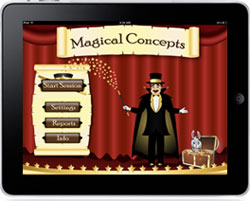The Enchanted Dictionary: Apps for our profession continue to get better and better. The Enchanted Dictionary apps for 4-6thand 7-12th grades are proof of how far app developers have come in producing apps that utilize the wonders of the iPad as they teach and challenge children. These two creative apps are not dictionaries in the Webster sense. Words are not looked up as much as they are taught. The teaching of word definitions occurs in categories: English/Language Arts, Mathematics, Science and Social Studies. Within these general categories are subcategories that offer definitions of terms specific to the subcategory. For instance, in the category of Mathematics are the subcategories of charts and graphs, geometry, measurement, number theory, probability and statistics and time. Tap on a subcategory and a list of words germane to that category appear to the right along with their definition. The fun way to utilize the apps is to tap on the Play! button on the upper left of the screen. But first, one has to select the words that will appear during play. One can choose Select All or Select None. Select None allows one to individually choose the words for play. Once one enters Play! an open book appears. The page on the right has the word that needs to be defined. The page on the left has a bunch of scrambled words that float around (hence enchanted). The student needs to arrange the floating words in correct order on the right so as to complete the definition of the word. One can drag or flick the words to the right. A word will move and stay to the right only if it is the correct word in the sequence of words needed to complete the definition. If the incorrect word is selected, it will float back to the left. Granted, students can guess around and drag/flick a word until it sticks and then randomly pick another word, thus avoiding thinking about the definition. Even so, at the point when all the words appear in correct order, the word is defined. Hopefully, the guessing student will read the definition, thus making it a learning experience anyhow. One has the option of adding or editing definitions, categories, or subcategories by simply tapping on the “Edit” button at the top of the screen.
I like the layout of the categories and definitions on the screen. The categories and defined words are written in bold black font. The definitions are written in gray beneath the words.
There is no scoring feature or database for keeping track of the progress of students. I asked the app’s developer Marg Griffin about this. She replied, “We didn’t add data collection to Enchanted Dictionary because we see it primarily as an intervention method to help students become more aware of how they learn vocabulary as well as how definitions are phrased. Because of that, how long it takes them to complete a definition or how many errors they make is less relevant than how much they improve in being able to use the targeted vocabulary in speaking or writing. That is the sort of data I track when I use it with my students.” Fair enough. The only problem is that school speech pathologists must collect data, no matter how senseless that task is. Perhaps a simple scoring feature might be included in an upgrade to help out our school colleagues.
I would recommend these apps to middle and high school teachers as well as speech pathologists. Priced at $1.99, they are a real bargain.
Ages: children in 4th-6th and 7th-12th grades
Ratings: ++++1/2
I like the layout of the categories and definitions on the screen. The categories and defined words are written in bold black font. The definitions are written in gray beneath the words.
There is no scoring feature or database for keeping track of the progress of students. I asked the app’s developer Marg Griffin about this. She replied, “We didn’t add data collection to Enchanted Dictionary because we see it primarily as an intervention method to help students become more aware of how they learn vocabulary as well as how definitions are phrased. Because of that, how long it takes them to complete a definition or how many errors they make is less relevant than how much they improve in being able to use the targeted vocabulary in speaking or writing. That is the sort of data I track when I use it with my students.” Fair enough. The only problem is that school speech pathologists must collect data, no matter how senseless that task is. Perhaps a simple scoring feature might be included in an upgrade to help out our school colleagues.
I would recommend these apps to middle and high school teachers as well as speech pathologists. Priced at $1.99, they are a real bargain.
Ages: children in 4th-6th and 7th-12th grades
Ratings: ++++1/2
Developer website: Goldencommunicationsllc.com
Cost: $1.99 each
Cost: $1.99 each

